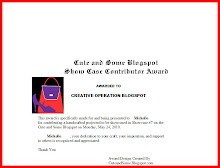Hey everybody!! I am finally getting this tutorial series underway!! WOO HOO!!! Thank you for being patient with me, I really appreciate it!
My plan is this: I am going to do the cover and binding today, and then start with the pages, a couple at a time. I am planning on trying to do the page tutorials on YouTube, as it will be a little bit easier to explain, but if it doesn't work out, I will do the tutorials all here on the blog. Either way, you will get all of the information you need to make your own "Tall Skinny Mini"!
Let's get busy!!! First, a few notes. The inspiration for this mini came from the "Witches Journal" I saw on YouTube. The use of the Tyvek for reinforcing the spine came from Kathy at Paper Phenomenon. It really does work and is a great way to recycle those Tyvek envelopes you get in mailings. The "Stack the Deck" binding is by Laura at Following the Paper Trail. The pages of this book are my creations. I sure hope you like them!
For this tutorial, I am going to use the papers from Basic Grey, Fact or Fiction, and Hello. I have three paper stacks and a bunch of accessories to embellish it with!
I also am going to use Bazzill card stock. You will also need some chipboard for the covers and some strong adhesive. I am using Score Tape...I love this stuff!
First, cut three pieces of chipboard for the covers, two at 12" x 6" and one at 12" x 2 1/2".
Adhere the cover pieces. This is what it should look like, this will be the inside of the cover.
This is the outside of the cover.
I inked up the corners of the book because they will not be totally covered with the card stock. This is important, because if the chipboard isn't inked you will be able to see it once the card stock is on the piece if it is not super precise.
I cut strips of card stock as follows: two at 12"x 1 1/2", and four at 9 1/4" by 1 1/2". These pieces will edge your chipboard piece. I like wrapped edges on my chipboard covers, so this is how I figured out how to cover the piece, since it is 12" tall. You don't have to do this, you can simply just cover the chipboard and trim the edges if you desire. If you decide to do that, ink the entire edge of your chipboard piece.
The pieces layered onto the card stock. The 12" pieces go on the sides, the others go on the top and the bottom. Use lots of score tape to adhere everything. And, DON'T FORGET TO PICK UP THE STRIPS OFF OF THE GUSSETS BY THE SPINE BEFORE YOU ADHERE THE CARDSTOCK COMPLETELY DOWN. See below.
Wrap your edges. I then used two pieces of patterned paper, cut 11 3/4" by 5 3/4", and covered the front and back outside covers. This leaves the spine exposed. I cut a piece of card stock at 12" x 6" and punched it. Before I did the punching I put score tape on the edge.
That way when you go to adhere the piece, all of the punched edges have adhesive on them!
This is the outside cover all done.
For the inside cover, I used the leftover 6" of card stock and covered the spine, then I covered the inside covers with more paper.
Here is my cover, all done. Now to the binding mechanism.I am making 10 pages for this book. This means you need five papers. They all, when stacked create a 1/4" gusset to allow for some room to embellish and add "stuff" to your pages.
Cut the card stock into 5 strips, 12" by 1 1/4", 1 3/4", 2 1/4", 2 3/4" and 3 1/4". Score each piece on each side at 1/2". This is what your page pieces will adhere to.
Side view of the binding.
If you desire, you can angle the edges of the binding pieces so that the pages adhere a little easier, but it's not necessary.
Once your binding piece is done, adhere it to the inside spine of your cover.
That concludes the first part. Next time, pages to put into your book. This is going to be fun!
Stay Crafty, My friends!


































I love the album,but never heard of Tyevk, what is it and where can I find it. I also wanted to know if you put in the page and then work on then , or do them then put them in. Thank you very much for shareing. Deana
ReplyDeleteyayyy .. this inspired me to make a mini ...thankyou for takin the time to show us what u did :0) i just grab a bunch if tyvek from the post office since they r free !
ReplyDeleteSorry just want to clarify the binding process, I assume that once you have cut and scored thr pieces they just sit inside each other. Your instructions do not actually make this step clear, and as I have not made one of these before but am dying to do so I wanted to make sure i was clear with the instructions.
ReplyDeleteRegards
Katrina
KATRINA TURNER, thank you so much for your question. Yes, they just sit inside of each other...use strong tape or wet glue for this part, as you want to make it a really strong binding. I used "Score Tape", I love that stuff. I can't wait to see your mini, if you post it or do a video I would love to see it!
ReplyDeleteThanks,
Michelle
DEANAMYERS, thanks for looking, I am so sorry this has taken me so long to see your question, I apologize, I don't know how I missed it. Tyevk is the "plasticky" durable material that some mailing envelopes are made from. You can buy it in any office store, just cut the envelopes apart to get the sizes you need. I usually bind the pages and then decorate them. It makes it easier to bind, rather that trying to work around the embellishments. Thanks again, and if you make one, I would love to see it, please let me know!
ReplyDelete